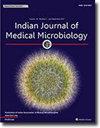利用 MALDI-TOF MS 对深层厌氧菌感染进行病原学诊断。
IF 1.4
4区 医学
Q4 IMMUNOLOGY
引用次数: 0
摘要
目的:深部脓肿可由不同解剖部位的多种细菌引起,准确识别这些细菌对于实施针对特定生物的治疗至关重要,可降低发病率和死亡率。MALDI-TOF MS 是一种强大的蛋白质组学方法,可快速准确地鉴定厌氧菌。本研究的目的是通过 MALDI-TOF MS(与 VITEK®2 ANC ID 卡和表型生化检验进行比较)研究深部感染,并确定已鉴定微生物的敏感性模式:无菌采集疑似深部感染患者的 104 份样本,进行显微镜检查、需氧/厌氧菌培养、MALDI-TOF MS 鉴定和抗菌药物药敏试验。厌氧菌也通过 VITEK-2 系统和表型生化测试进行鉴定:在检测的 104 份样本中,41.3%(43/104)呈阳性结果,主要是脓液样本(88%)。在 21% 的阳性病例中发现了混合感染。从阳性标本中鉴定出的 52 种微生物中,19.2%(10/52)为强制性厌氧菌,其中以脆弱拟杆菌属最为普遍,其次分别为产气荚膜梭菌和产气荚膜梭菌。大肠杆菌是最常见的兼性厌氧菌。通过 MALDI-TOF MS,成功地鉴定出了所有厌氧菌的种类。相比之下,VITEK®2 ANC ID 卡只能鉴定出 40% 的厌氧菌(4/10)达到物种水平。所有厌氧菌对甲硝唑、万古霉素和厄他培南的敏感性均为 100%。25%的乳杆菌属和 50%的产气荚膜梭菌分离物对克林霉素有耐药性:结论:MALDI-TOF MS 是一种有益的细菌鉴定诊断工具,省去了耗费大量人力和时间的传统微生物学方法。MALDI-TOF MS 鉴定的准确性还有助于抗击抗生素耐药性,改善深部感染患者的治疗效果。本文章由计算机程序翻译,如有差异,请以英文原文为准。
Utilization of MALDI-TOF MS in the etiological diagnosis of deep-seated anaerobic bacterial infections
Purpose
Deep-seated abscesses can be caused by a wide array of bacteria in various anatomical sites, the precise identification of which is crucial for implementing organism-specific treatments which can reduce morbidity and mortality. MALDI-TOF MS is a powerful proteomic method for the swift and accurate identification of anaerobic organisms. The aim of this study was to investigate deep-seated infections by MALDI-TOF MS (in comparison to VITEK®2 ANC ID card and phenotypic biochemical tests) and to determine the susceptibility pattern of identified microorganisms.
Materials and methods
A total of 104 samples from patients suspected of deep-seated infections were aseptically collected and subjected to microscopy, aerobic/anaerobic cultures and subsequent identification via MALDI-TOF MS followed by antimicrobial susceptibility testing. Anaerobic bacteria were also identified using the VITEK-2 system and phenotypic biochemical tests.
Results
Out of the 104 samples tested, 41.3 % (43/104) showed positive results, predominantly in pus specimens (88 %). Mixed infections were found in 21 % of the positive cases. Of the 52 organisms identified from positive specimens, 19.2 % (10/52) were obligate anaerobes, with Bacteroides fragilis group being the most prevalent, followed by both Clostridium perfringens and Clostridium sporogenes respectively. Escherichia coli was observed to be the most common facultative anaerobic isolate. All obligate anaerobes were successfully identified to the species level via MALDI-TOF MS. In contrast, the VITEK®2 ANC ID card identified only 40 % (4/10) anaerobic bacteria to the species level. All obligate anaerobic organisms showed 100 % susceptibility to metronidazole, vancomycin and ertapenem. 25 % of the Bacteroides spp. and 50 % of Clostridium perfringens isolates were found to be resistant to clindamycin.
Conclusion
MALDI-TOF MS proves as a beneficial diagnostic tool for bacterial identification, eliminating the labour-intensive and time consuming conventional microbiological methods. Its accuracy of bacterial detection further helps in combating antibiotic resistance and improving patient outcomes in deep-seated infections.
求助全文
通过发布文献求助,成功后即可免费获取论文全文。
去求助
来源期刊

Indian Journal of Medical Microbiology
IMMUNOLOGY-
CiteScore
2.20
自引率
0.00%
发文量
154
审稿时长
73 days
期刊介绍:
Manuscripts of high standard in the form of original research, multicentric studies, meta analysis, are accepted. Current reports can be submitted as brief communications. Case reports must include review of current literature, clinical details, outcome and follow up. Letters to the editor must be a comment on or pertain to a manuscript already published in the IJMM or in relation to preliminary communication of a larger study.
Review articles, Special Articles or Guest Editorials are accepted on invitation.
 求助内容:
求助内容: 应助结果提醒方式:
应助结果提醒方式:


